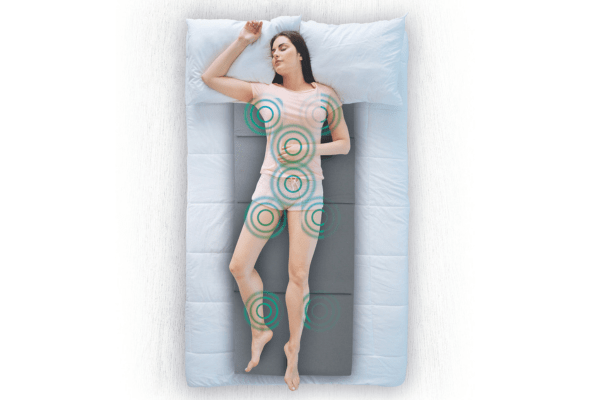Osteoporosis is a systemic bone disease. It is characterized by a reduction in bone mass and bone tissue microarchitecture’s alteration.
This disease generates progressive bone rarefaction and bone demineralization, also called decalcification.
This is due to a reduction in the amount of calcium and other minerals in the skeleton’s bones.
Simply put, lack of calcium causes bones to weaken and become more prone to fractures. These fractures are not necessarily caused by trauma but can also depend on other reasons such as a stressful condition.
Osteoporosis can affect all bones of the skeleton, men and women of all ages. When it affects the entire skeleton, it is called diffuse osteoporosis.
Other times, however, the disease is localized to more specific body areas. In this case, the most common forms are osteoporosis of the femur, lumbar osteoporosis, osteoporosis of the hands, osteoporosis of the hips, and even osteoporosis of the spine.
At what age does osteoporosis begin?
The most common osteoporosis occurs after menopause, when levels of estrogen, which protects bones, decrease dramatically. This increased risk of fractures (especially to vertebrae, femur, wrist, humerus, and ankle) can occur even with mild trauma.
About 40% of the population suffers a femur, vertebra, or wrist fracture during their lifetime, especially after the age of 65.
Juvenile osteoporosis
Juvenile osteoporosis refers to forms of osteoporosis that occur during childhood and adolescence. It can be caused by genetic mutations that alter bone connective tissue or abnormal osteoblast activity. Other causes include leukemias, prolonged immobilization, chronic disease, or use of certain medications. When there is no identifiable cause, it is called juvenile idiopathic osteoporosis.
Symptoms of osteoporosis
The symptoms of osteoporosis do not occur right away. The first pains are felt when the disease has already begun to weaken the bones.
Usually, these pains are caused by fracture or collapse of the vertebrae, but they can also depend on fracture of the wrist, femur, or other bones.
Symptoms may occur in different situations depending on the form of osteoporosis.
In the case of lumbar osteoporosis and hip osteoporosis, initial symptoms may appear after standing for a long time and fade when lying down, especially to sleep at night.
In addition, in osteoporosis of the hip, femur, and spine, sometimes symptoms may only be felt following a fracture of the hip, femur, or vertebra.
In the case of osteoporosis of the hands, the symptoms should not be confused with those of arthrosis. In fact, arthrosis is a disease that does not affect the bones but the joints.
Where does osteoporosis manifest itself ?
Osteoporosis is a disease that can remain silent for years, often manifesting for the first time with a fracture, either vertebral or nonvertebral. Vertebral fractures are the most common, especially in postmenopausal women.
Other body parts mainly affected by osteoporosis are: shoulder, hip, wrist and ankle.
Difference between osteopenia and osteoporosis
The difference between osteopenia and osteoporosis is based on bone mineral density (BMD). The T-score, a parameter that compares the patient’s bone density with that of a healthy 30-year-old adult, is used for diagnosis. A T-score between -1 and -2.5 indicates osteopenia, while a value below -2.5 indicates osteoporosis. Osteopenia is a condition in which bones are weakened, increasing the risk of fractures, while osteoporosis represents a more severe condition with porous and brittle bones.
Osteoporosis: the causes
The causes of osteoporosis are many and varied.
Risk factors can be reduced to some extent, but some of them, such as age, gender, ethnicity, or family history, cannot be controlled.
Women, for example, suffer from it much more than men. This difference is most noticeable at the arrival of menopause. During this period, estrogen production is reduced, contributing to the reduction of bone mass.
Risk factors that can instead be controlled, if not eliminated, include:
● alcohol abuse
● coffee
● salt
● fiber supplements
Leading a sedentary lifestyle and a diet deficient in calcium, protein, and vitamin D can also prevent optimal skeletal growth and increase the likelihood of being affected by osteoporosis. In fact, calcium and vitamin D deficiency leads to bone decalcification.
Finally, another risk factor to consider is having suffered fragility fractures in the past.
Examinations and diagnosis of osteoporosis
Instrumental diagnostics are crucial in the management of osteoporosis. It includes various examinations such as radiographs, bone densitometry (DXA), bone ultrasonography and MRI, which help diagnose the disease, monitor it over time, and conduct research.
The reference test is bone densitometry, also called MOC, or “computed bone mineralometry.”
The diagnosis of osteoporosis can be made by a medical specialist, usually an orthopedist, through densitometry bone (MOC), precisely. Today, MOC is performed using an X-ray absorptiometry technique also called DEXA.
MOC can identify or confirm a diagnosis of osteoporosis, determine the risk of future fractures, and monitor the treatment’s effects. However, monitoring is only possible if it is performed at regular intervals.
Other tests can also be useful: blood tests, for example, are intended to determine values such as calcemia, which indicates the calcium content of the blood.
Radiography is useful for detecting fractures in the most affected areas, such as the spine and femur. Finally, absorbimetry measures bone density and can monitor disease severity through changes in the patient’s height.
Osteoporosis and prevention
We can divide osteoporosis prevention into 3 stages: primary, secondary and tertiary.
Primary prevention is fundamental. In fact, to avoid bone loss, it is important to maintain an active lifestyle with moderate physical activity, follow a diet rich in calcium and protein, and limit the use of alcohol and tobacco. Special attentions should also be paid to pregnant and menopausal women. In the former case, they should increase their calcium intake; after menopause, on the other hand, vitamin D supplementation is recommended, as this is essential for calcium absorption.
Secondary prevention focuses on early detection using tools such as bone density measurement, while tertiary prevention targets those who have already suffered fractures to prevent further damage.
How to cure osteoporosis
But what are the possible treatments for osteoporosis?
Although it cannot be cured permanently, following a healthy, balanced diet is the first cure for osteoporosis. The diet should include an important intake of calcium and vitamin D and should be rich in fruits and vegetables. It must also be accompanied by a healthy lifestyle.
Quitting smoking and minimizing alcohol intake is one of the most important conditions in the treatment of osteoporosis, while engaging in physical activity is especially important for prevention, particularly when it is outdoors.
In menopause, treatment of osteoporosis is based on the use of natural estrogen to prevent bone loss. For other forms of osteoporosis, treatment aims to address the underlying cause.
In fact, if the doctor prescribes it, therapy with bisphosphonate drugs, which can reduce bone resorption, is possible.
Alternatively, one can take drugs that stimulate bone tissue formation such as those that include calcium, vitamin D, and antiestrogens such as Raloxifene, which increase bone density, reducing fractures. Drug therapy is often combined with vitamin D and calcium supplements to optimize results.

PEMF Therapy and osteoporosis
Regarding instrumental physical therapy, magnetotherapy (PEMF Therapy) is particularly indicated for hard tissue treatment, delayed bone calcification, and thus also for osteoporosis.
As mentioned, it is a systemic disease, that is, it involves the entire skeletal system of our body.
Therefore, it is useful to have a treatment that allows simultaneous action on all areas affected by the pathology, leaving the patient comfortable during the several recommended hours of treatment. For these full-body treatments, it is ideal to use an applicator such as the Osteomat that provides a comfortable surface on which to lie during nighttime therapy.
If you are wondering where you can have a magnetotherapy treatment, know that in addition to hospitals and clinics, you can also have the therapy at home. Yes, you got that right!
This is made possible by certified electromedical devices that bear the CE mark followed by the number of the notified body, attesting to the product’s compliance with European medical device directives. This, together with the soundness of the manufacturing company, ensures safe and easy treatment in the comfort of home.
A consultation with your doctor and corresponding prescription is always recommended before starting therapy.
How often to do magnetotherapy for the treatment of osteoporosis?
In general, magnetotherapy requires medium to long treatment times, as underlined by clinical studies in the scientific literature. Cycles of 45-90 days with sessions of at least 3 hours per day are usually recommended, unless the physician provides different indications. If necessary, treatment can be repeated several times during the year for conditions such as osteoarthritis, arthritis, joint pain, and indeed osteoporosis.
If you’re wondering what parameters to set for treatment, don’t worry! Our magnetotherapy devices feature preset programs based on clinical studies so starting your therapy will be really simple and straightforward, just a couple of clicks away!
Are you considering purchasing a magnetotherapy device or just want more information? Contact our customer service team, always ready to take care of you!






